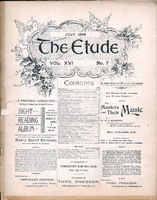[Our subscribers are invited to send in questions for this department. Please write them on one side of the paper only, and not with other things on the same sheet. In Every Case the Writer’s Full Address must be Given, or the questions will receive no attention. In no case will the writer’s name be printed to the questions in The Etude. Questions that have no general interest will not receive attention.]
E. N.—We wish that it were possible to tell you an authoritative way for writing the chromatic scale. Unfortunately the practice of composers is largely a matter of personal choice, and theorists also differ widely. A common rule is to use sharps in an ascending, flats in a descending passage. English theorists, who follow what is known as the Day system of harmony, advocate writing the scale alike, ascending and descending. They derive the notes from harmonies belonging to the keys. For example: The scale of C includes C-major and C-minor; the latter key adds the two chromatic notes, E-flat and A-flat; F-sharp is derived from a major chord on the super-tonic D, which chord may resolve on the tonic, either in the first or second inversion, hence belongs to the C scale; B-flat is derived from a chord of the seventh founded on the tonic; D-flat from a major chord, which has F and A-flat for third and fifth and D-flat for a root. This gives a chromatic scale of C as the regular succession of C-major with the addition of D-flat, E-flat, F-sharp, A-flat, B-flat.
In his work on harmony, just issued by the publisher of The Etude, Dr. Clarke gives directions for the writing of the chromatic scale that will enable a composer to be thoroughly consistent. They are founded on the principle just mentioned, but differ slightly. Harmony plays such an important part in modern music that it seems to be proper that all writing should have reference to harmonic combination rather than melodic progression.
M. E. C.— 1. Your quandary as to what position to use in writing chords from a figured bass is one that has been faced by many others. Some theorists indicate the position of the first chord in an exercise, after which the rules for chord-progression determine the positions of the several chords. We can see no reason why you should be troubled about the position of those chords, which are inversions, the positions being determined by the context.
2. The new work on harmony, by Dr. H. A. Clarke, is designed to meet the demand for a work adapted to self-instruction.
L. C.—By waltz time is usually meant ¾ time, played rather fast; the metronome may be set at from 60 to 88 to a dotted half-note. The publisher of The Etude will send a circular giving general directions for the use of a metronome.
a. N. D.—1. Repeat marks are not observed in a da capo. Composers frequently give the direction da capo al fine senza repetizione, “from the beginning to the end without repeat,” but the words da capo are considered as implying the longer phrase.
2. See the answer to M. E. C.
M.—Some good collections of classical music of a fair degree of diffculty (sic) are: “Concert Album” (classical), $1.00; “Classic Piano Solos,” Volumes I and II, each $1.25; “Classical Pianist,” $1.25; “Artist Repertoire,” 50 cents; “Pianist Anthology,” $1.00.



